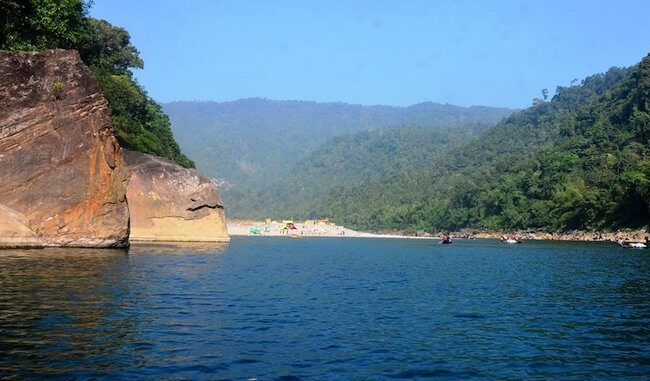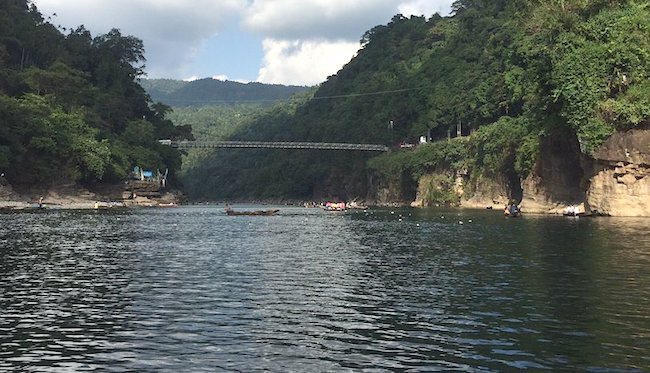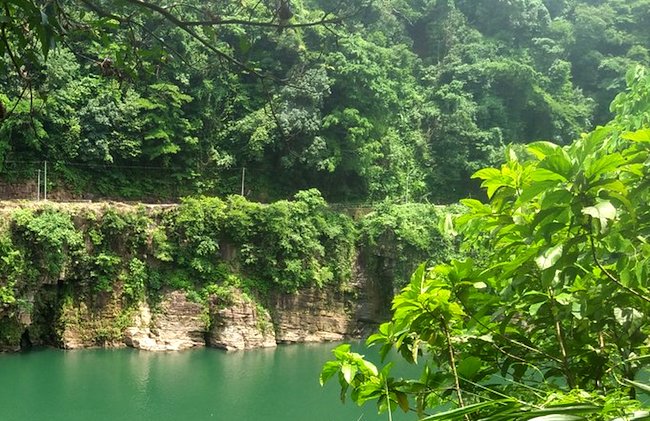
Minutes before sundown, we surrender our sanity and walk across the border into alien territory. Neither of us is carrying a passport. Nor thinking of what might happen if the Indian Border Security Force personnel reject our documents – a driving licence and an Aadhaar card – as valid ID and prevent us from re-entering our own country when we return.
The day’s got off to a rocky start, with my rebellious stomach periodically disgorging its undigested contents for much of the 85 km drive through hilly terrain from Cherrapunjee to Dawki, a small trading hub located in the East Jaintia Hills where Meghalaya meets Sylhet district in Bangladesh. The rest of the journey has passed in an Avomine-induced stupor. The sight, however, of two Indian Army soldiers perched on boulders overlooking the gorge to our right jolts me into alertness.
India Bangladesh border
Are we approaching the India–Bangladesh border? No idea. Signboards are conspicuously absent and our dour local driver Rawa’s commando-like concentration on the road’s dizzying bends discourages queries.
The border isn’t my focus, though. Nor is Bangladesh, my father’s nostalgia-shrouded birthplace. I’m eager for a glimpse of the Umngot River in Dawki that flows between the two countries. Never have I seen a waterway look so magical in photographs, so crystal-clear that boats moving across it seem to glide through space, as though zooming off on an invisible broomstick. No wonder everything else – the densely wooded cliff rising to our left as we drive on, the exotic-looking butterfly we photograph during one of my retching halts, the waterfalls and gorges – seems unexceptional, although we’re travelling through one of India’s most beautiful northeastern states.
The late afternoon light is mellowing when Rawa brings the car to a halt. “Hmphh!” he grunts. Decoded, it means we’ve reached our destination.
Dawki: Umngot river
In seconds, I’m out and off, peering over the edge of the precipice into the gorge. Cradled in its depths by vertical rock faces is an expanse of rich blue-green water, so dense in appearance, it could be a precious jewel from an imaginary realm. Boats plying along it look like flimsy matchsticks from this height. The very thought of the majestic Umngot lending itself to aquatic sports – one of its attractions, apparently – seems demeaning. At one end, the river flows into an inlet. At the other, it curves past the wall of cliffs hemming it, breaking away into freedom. But what’s that, projecting into the water in the distance – an elongated sandbank? Slicing it lengthwise in two is a barrier – a single wire – running all the way at chest height. On the far side of this “border”, women in colourful sarees and men in lungis and kurtas, long robes and prayer caps take the evening air. It’s hard to imagine them as “foreigners”, harder still to accept that a mere wire determines where India should end and Bangladesh begin.

With the sun skimming the horizon, such reflections must wait. There’s barely enough time to go out on the water for a closer look at our “neighbour”. We rush down to the riverbank far below, hire a boat and are soon pulling away from the boarding area. Our local Khasi boatman points out various attractions along the way – the single-span suspension bridge built in 1932 by India’s British colonial rulers that straddles the watercourse and serves as the land route to Tamabil across the border; the fishing boats that have taken up strategic positions along the river.
But deep within the Umngot lies a world seemingly transported from another dimension. Resembling a giant opaque slab of some rare gem from high above, the river is actually as transparent as glass. Far below its surface stretches its vast, sandy bed. Boulders – large, small, plain, speckled, black, grey, beige, off-white – rise here and there, offering crevices and hollows for shoals of tiny fish to play hide-and-seek. Could a water nymph be lurking there? I wouldn’t be surprised if there were, for a strange, subterranean glow lends this underwater universe the surreal beauty of a dream.
The dream dissolves and my mind reluctantly readjusts its focus as the boat draws to an unannounced mid-river halt. On another vessel waiting nearby, a fisherman, still as a statue, tenses. I notice his companion’s expression – a predator’s, ready for the kill.
Fresh water shark fishing
“God, that’s a whopper he’s caught!” our boatman hisses in excitement, staring at the twitching fishing line.
The drama plays out in silence: the catch is reeled in by one man; the other manoeuvres the line artfully, relentlessly, to disorient and exhaust their prey. Time stands still. Then it’s heaved out of the water with a flourish. Not the water nymph of my imagination, but a monstrously large creature, weighing over five kilos. Landing in the boat, the giant catfish, known for its fierce survival instincts, thrashes around in a vain bid to escape. When it’s finally motionless, one of the fishermen attempts to unhook it. The fish strikes back with a savage bite. Awestruck by its combative spirit, even in the throes of death, I’m beginning to understand why the species, locally recognised as the boal, is also referred to as the freshwater shark. Never has fishing seemed quite so much like a battle. How long will this one last?
Bangladesh from Dawki Meghalaya
There’s no time to find out. Bangladesh is tantalisingly close, but if we don’t hurry, darkness will devour it.

Soon, we’re stepping out on the sandbar where I’d noticed people milling around. As we crest the rise, the strip unfurls into a much wider expanse of undulating land. The crowd across the “wire” – just a thick blue nylon rope, I discover – has dispersed. The women are long gone. A few men in prayer caps loiter, staring at us through surma-lined eyes. An old man with a flowing silver beard smiles amiably. Lined up within touching distance on the other side of the rope are some friendly young vendors from Brahmanbaria, who entreat us to taste their pickled plums and jhaal muri, the Bangladeshi version of bhelpuri. Payment in Indian currency is welcome.
My friend succumbs to temptation. Cross-border trade takes place as money and goods change hands across the “Line of Control” – the nylon rope, one end of which has given up all pretence and collapsed in a heap. A young Bangladeshi sentry looks on indulgently. A trio of saree-clad women approaches from “our” side and addresses the uniformed man in Bengali flecked with a lilting accent. His compatriots? Apparently not.
Crossing over
“Could we cross over? Just for a few minutes?” they ask. “We won’t get into trouble, will we?”
The man cheerfully allays their fears and raises the rope to allow them through. The urge to follow suit is irresistible. I remember the two jawans I had noticed on our way here and look around in vain for an Indian checkpost or some form of surveillance. The concept of a “porous” border has never been more unambiguous.
“May we?” my friend and I ask the Bangladeshi sentry.
“Bengalis, are you?” he says, beaming. “Come on over!”
In seconds, we’re in foreign territory, a land that looks exactly like our own, but isn’t. The sentry leads us away from the vendors and introduces himself. His name marks him as a member of his country’s minority community. The conversation he initiates is strange, unnerving, punctuated with endless questions. Are we from Kolkata? In which locality do we live? Do we know that he has family living in my city’s Park Circus area? Why don’t we FaceTime his relative in London? Could he have our phone numbers? I sense urgency, even desperation in his manner. I’m wondering where all this is leading when he makes a surprising confession: he’s resigning from his post soon and crossing the border into India. His wife and children are already in Kolkata.
“Really?!” we exclaim, surprised.
“Shh!” he cautions. His voice drops a notch. “It’s difficult for us here. Things have changed.”
Darkness has descended. Not a soul is in sight. We bid the sentry good-bye and head back. No Border Security Force soldier looms up to confront us as we slip under the rope and into India. The Umngot looks dark and sinister. A solitary Khasi boatman stares at us, intrigued.
“You ladies crossed to the other side?” he asks in Hindi.
His query goes unanswered. My thoughts linger on the sentry from the land that seems like ours, but isn’t. The memory suddenly surfaces of a lone fish swimming in familiar waters, unaware that danger lurks. I can still see it thrashing around in the boat following its capture, desperate to escape a suddenly hostile environment. And I wonder if I can ever shake off the moment of its final, futile bid for survival – the last death-defying act of resistance – before it’s overpowered.

Leave a Reply